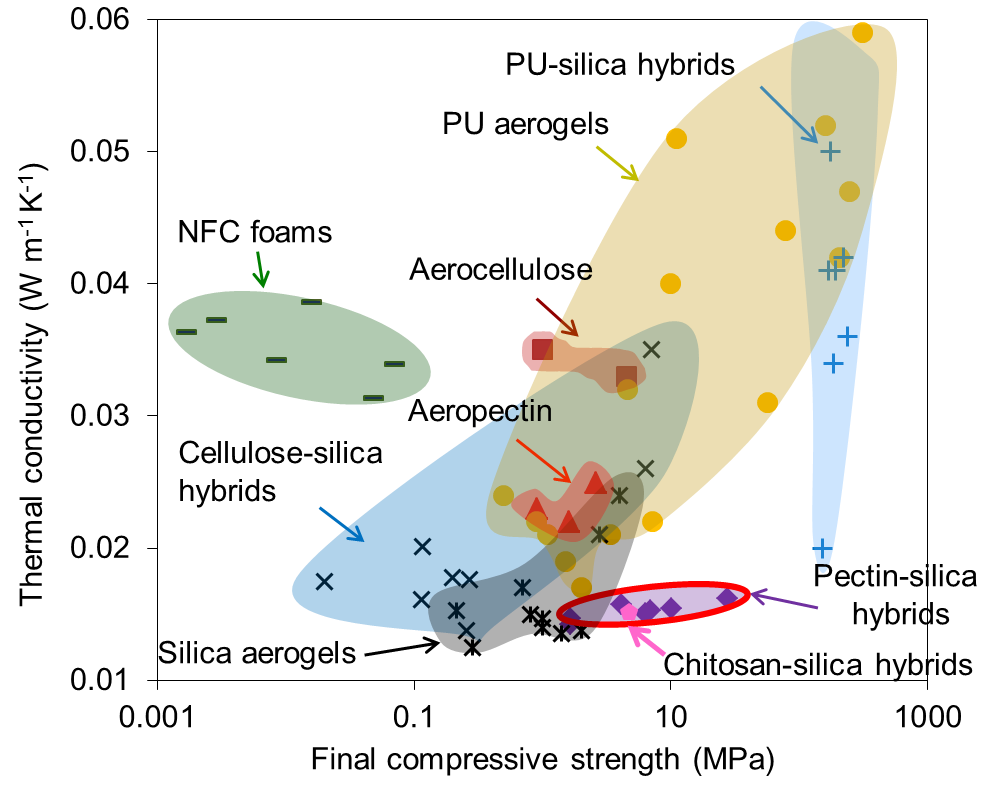Biopolymer-silica aerogel nanocomposites with improved thermo-mechanical properties
Silica aerogel is an outstanding thermal insulator, but it’s brittle and rather dusty nature restricts the applications[1] [2]. Here, we report on monolithic, lightweight and nanostructured superinsulating aerogel nanocomposites that are reinforced by cogelation with biopolymers. Polysaccharides (pectin and chitosan) are dissolved into an aqueous silicic acid solution, followed by co-gelation, polymer coagulation, hydrophobization and supercritical drying. The morphology and properties of the resulting materials can be tuned by adjusting the gelation pH and biopolymer concentration. The specific surface area, porosity, microstructural and mechanical properties, as well as thermal conductivity and humidity uptake were systematically evaluated. Aerogel nanocomposites made at low acidic pH (~1.5 for pectin and ~3 for chitosan) exhibit a high plastic deformation region with no rupture until at least 80% strain, in addition to a greatly increased yield strength (2-27 MPa versus 1 MPa for silica aerogels) and compressive modulus (up to 9.0 MPa). Importantly, the reinforcement does not significantly increase the density (ρ=0.11-0.18 g/cm3) and thermal conductivity (λ=14.2-18.3 mW·m-1·K-1)[3]. The changes of thermo-mechanical properties are linked to a ‘neck-free’ nanoscale network structure with thicker struts compared to the classical pearl-necklace structure of silica aerogels. This new class of biopolymer-silica nanocomposite aerogels opens up new perspectives for a wide range of thermal insulation, sorption, catalysis and other applications, where structural integrity is indispensable.

Figure 1. Thermal conductivity versus final compressive strength for aerogel-like materials. [3]
[1] J. C. H. Wong, H. Kaymak, S. Brunner, M. M. Koebel, Microporous Mesoporous Mater. 2014, 183, 23. [2] S. Ratynskaia, H. Bergsåker, B. Emmoth, A. Litnovsky, A. Kreter, V. Philipps, Nucl. Fusion 2009, 49, 122001; H. F. Krug, Angew. Chem. Int. Ed. 2014, 53, 12304. [3] S. Zhao, W. J. Malfait, A. Demilecamps, Y. Zhang, S. Brunner, L. Huber, P. Tingaut, A. Rigacci, T. Budtova, M. M. Koebel, Angew. Chem. Int. Ed. 2015, 54, 14282; S. Zhao, W. J. Malfait, E. Jeong, B. Fischer, Y. Zhang, H. Xu, E. Angelica, W. M. Risen, J. W. Suggs, M. M. Koebel, ACS Sustainable Chem. Eng. 2016, 4, 5674.